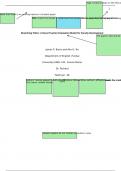Exam (elaborations)
APA FORMATTING STYLES
A large body of assessment literature suggests that students’ evaluations of their teachers (SETs) can fail to measure the construct of teaching in a variety of contexts. This can compromise faculty development efforts that rely on information from SETs. The disconnect between SET results and fac...
[Show more]



